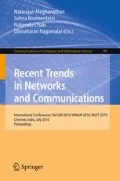Abstract
Due to the high complexity of modern circuit designs, verification has become the major bottleneck of entire design process. Common industry estimates are that functional verification constitutes near 70% of the total effort on any ASIC project. In this paper, we have tried to describe various ways to optimize verification time, comparing their effect on verification time and complete design cycle, with the conclusion of selecting modeling as better mechanism. The present paper has proved modeling as the best approach for optimizing ASIC design cycle with the experimentation taking a case-study.
Access this chapter
Tax calculation will be finalised at checkout
Purchases are for personal use only
Preview
Unable to display preview. Download preview PDF.
References
Gallagher, J.: Verification techniques:going beyond simulation. Synplicity (2004)
Mudigoudar, B.: FPGA Prototyping for fast and efficient verification of ASIC H.264 decoder, The University of Texas, Arlington (May 2006)
Abbe, J.: Verification Reuse Methodology, white paper (April 2002), http://www.verisity.com
Bergeron, J.: Writing Testbenches using SystemVerilog. Springer, Heidelberg (2006)
Santarini, M.: Cadence moves toward intelligent testbench. EE Times (June 1999)
Brown, S.: TLM Driven Design and Verification, white paper (June 2009), http://www.cadence.com
Einfochips, http://www.einfochips.com/download/Tech_June04.pdf
Mcmillan, K.: Assertion-Based Verification, Cadence Berkeley Labs (2005)
Bailey, B.: Co-Verification: From Tool to Methodology, white paper (June 2002), http://www.mentor.com
Klein, R.: Solving problems early on using co-verification. SoC Verification Business Unit Mentor Graphics Corp. (November 2004)
Advantages of Model-based design, http://www.xilinx.com
Lam, W.K.: Hardware design verification. Pearson Education, London (2005)
Author information
Authors and Affiliations
Editor information
Editors and Affiliations
Rights and permissions
Copyright information
© 2010 Springer-Verlag Berlin Heidelberg
About this paper
Cite this paper
Shah, V., Parmar, N., Shah, R. (2010). Optimization of ASIC Design Cycle Time. In: Meghanathan, N., Boumerdassi, S., Chaki, N., Nagamalai, D. (eds) Recent Trends in Networks and Communications. WeST VLSI NeCoM ASUC WiMoN 2010 2010 2010 2010 2010. Communications in Computer and Information Science, vol 90. Springer, Berlin, Heidelberg. https://doi.org/10.1007/978-3-642-14493-6_4
Download citation
DOI: https://doi.org/10.1007/978-3-642-14493-6_4
Publisher Name: Springer, Berlin, Heidelberg
Print ISBN: 978-3-642-14492-9
Online ISBN: 978-3-642-14493-6
eBook Packages: Computer ScienceComputer Science (R0)

